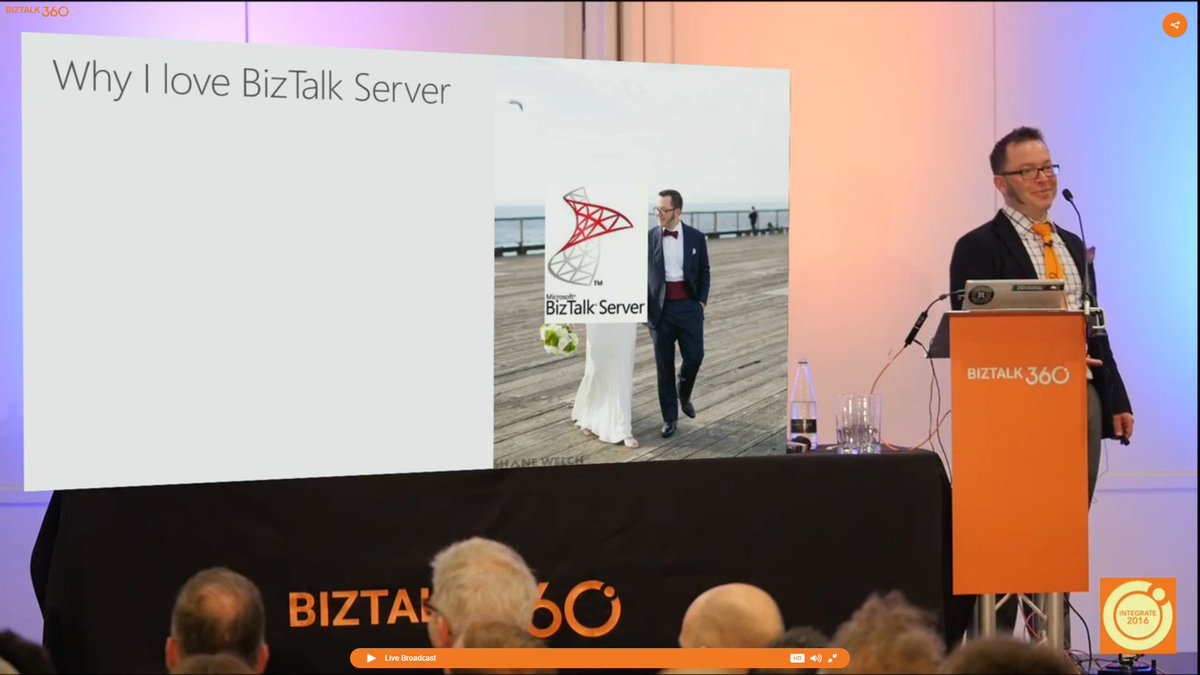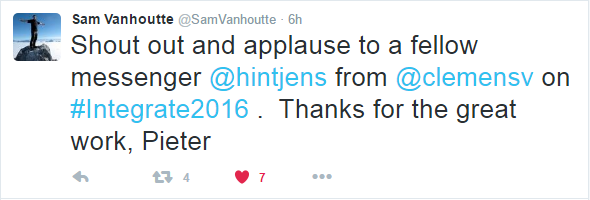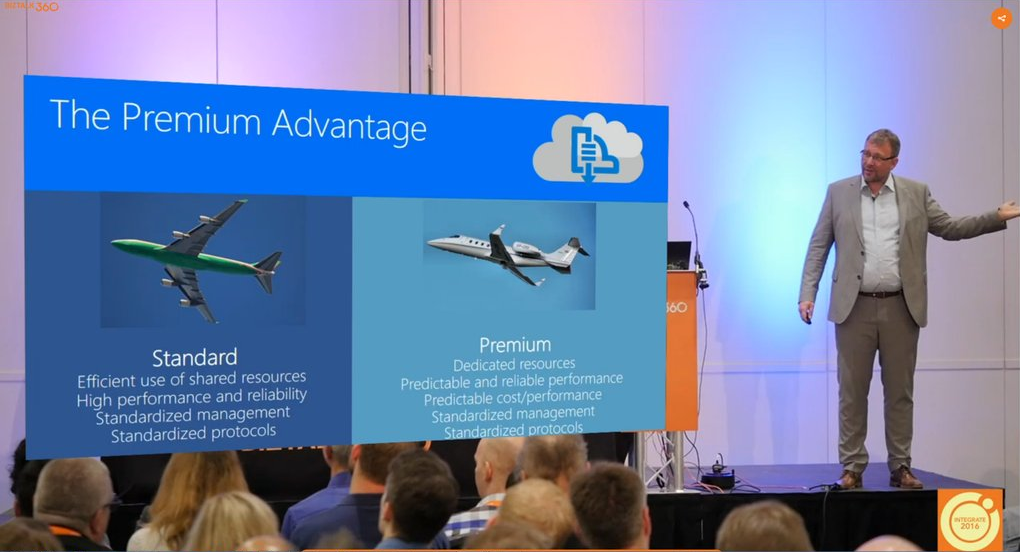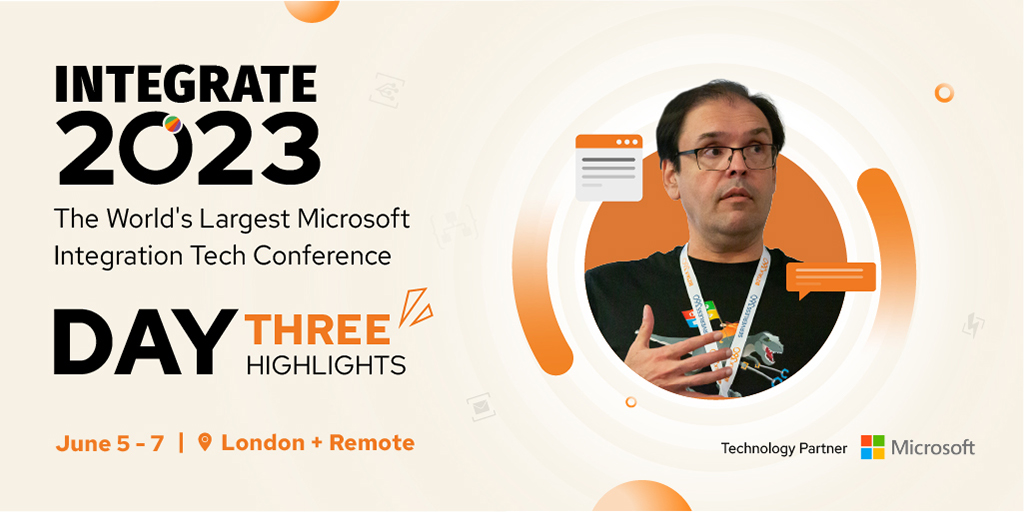BizTalk Summit in London only got bigger and better this year as INTEGRATE 2016. Microsoft usually has very little representation for integration topics at //build/ and TechEd events. INTEGRATE 2016 is the place to be for technologists interested in Microsoft Integration Platform. Right from the Keynote and the following sessions by speakers from Product Group, lots of work is being done and the roadmap looks very strong.
Day two started with the session on Azure Functions & Azure App Service. It was followed by sessions from Azure Service Bus team. Here are some highlights:
A Powerful, Scalable, Service Bus in the Cloud – INTEGRATE 2016
Dan Rosanova made the day with a very personal talk sharing his interesting experiences with BizTalk. He is very passionate and this picture shows how much he loves this platform He started the session by explaining some misconceptions he had from his early years on messaging:
He started the session by explaining some misconceptions he had from his early years on messaging:
- Centralized schemas, which looked like a good idea
- Mapping at the port level is always the right choice
- Compensating for bad Line of Business design by doing more work in middleware
Many of these lead to developing integration solutions that had overheads and complexities done in the middleware. BizTalk may be a truly distributed, but it uses DTC which is heavily dependent on a single point of centralization. Mostly, the integration solutions were difficult to grow, change, maintain with the existing resources. Some of the right things about messaging:
- Separation of concerns
- Compartmentalization of logic
- Minimization of lateral dependencies
- Small Orchestrations are possible
- MSI deployment and Continuous Integration
Service Bus Premium Messaging
- is built on resource isolation
- delivers enterprise-grade performance consistency
This doesn’t mean speed, but predictability in terms of performance and pricing.
- up to 4 Messaging Units (MU) per namespace could be purchased off the shelves but can be expanded by approaching Microsoft directly
- can process ~ 3000 msg/sec per MU
Having said that, he also referred to the CAP theorem, that it is impossible for a distributed computer system to simultaneously provide all the three – Consistency, Availability and Partition Tolerance. This is also applicable to Service Bus Messaging
Announcements
1. Event Hubs Native Java Clients
- Written on top of Proton-J
- Works great with Docker, ACS and Docker Swarm
2. Azure Event Hubs Dedicated Capacity
- built as a Single Tenant model for large-scale customers
- similar in service as Event Hubs
- can process messages of size 1MB.
- No ingress and count limits, which is great
so the pricing changes, no more billing on usage basis i.e. No per usage or per hour charges: fixed monthly pricing model. Also comes with a 3 Month committed purchase restriction.
He also suggested trying some concepts of messaging through:
- Ingress 1000s of events per second to EventHubs
- Set a 5-minute tumbling window showing values outside of a determined range using Stream Analytics
- Send them to a Service Bus Queue
- Take action in a Logic App
The numbers he was mentioning were whopping!
Service Bus Messaging processes 100 Billion ingress events/day. Processed 2.7182 Trillion requests last week with 99.9984% success rate which leaves 44.5814 million errors, thus leaving the success numbers mind blowing!
Service Bus – Roadmap, What’s next? – INTEGRATE 2016
Clemens Vasters presented a more promising Roadmap for Service Bus Messaging but only after thanking the messenger from the historic times like Pony Express and the software veterans who contributed for the innovations in messaging.

– Innovation in Messaging space has rapidly accelerated
– Need to embrace open protocols
- AMQP 1.0 – Robust, symmetric message transfer protocol
- MQTT 3.1.1 – telemetry Transfer Protocol
– Messaging products getting more diversified
- High-Availability, High-Scale Message Brokers
- Event Ingestors
- Bi-Directional IoT Gateways
- Large-Scale Event Distribution
Announcements
- AzureServiceBus will eventually standardize on AMQP 1.0 rather than HTTP or SBMP
- Both Service Bus and Event Hubs will be coming to Azure Stack as future for Service Bus for Windows Server (although not in 2016)
- Event Hubs Dedicated Capacity model just announced for large scale customers
Microsoft Broker Platform Options for 2016
- Service Bus for Windows Server 1.1 – On-Prem and IaaS
- Windows Azure Pack Service Bus for Windows Server 1.1 – Private Cloud
- Microsoft Azure Service Bus (PaaS) – Public Cloud (Standard & premium)
Programming Model and Platform Options
For the AMQP 1.0 –
- availability of WCF on .Net Service Bus SDK
- availability of Apache Proton C for C/C++ and Embedded systems
- Apache Qpid, JMS AMQP 1.0 for Java/JMS systems
For the HTTP(S) –
- Python client
- PHP client
- Node.js client
- Any HTTP client
Azure Service Bus Messaging (Standard)
- World-Class Scale, Availability and Reliability
- Instant, Automated Failure Recovery
- Fully Managed PaaS messaging infrastructure
- Standards based (AMQP 1.0, HTTP)
- Transaction-based Pay-As-You-Go pricing
- Available World Wide
Azure Service Bus Messaging (Premium)
- All capabilities of Azure Service Bus Messaging (Standard)
- World-Class Predictability and Performance
- The introduction of Jet Stream storage engine of Azure Event Hubs
- Dedicated, reserved capacity for higher predictability and performance
- Predictable, daily flat-rate pricing
This could not be explained much better than this picture Last but not the least, Azure Stack is available for a price. @clemensv mentions it will be competitively priced from its competitors
Last but not the least, Azure Stack is available for a price. @clemensv mentions it will be competitively priced from its competitors

All these clearly shows Microsoft is changing and the vision for Integration is great!







